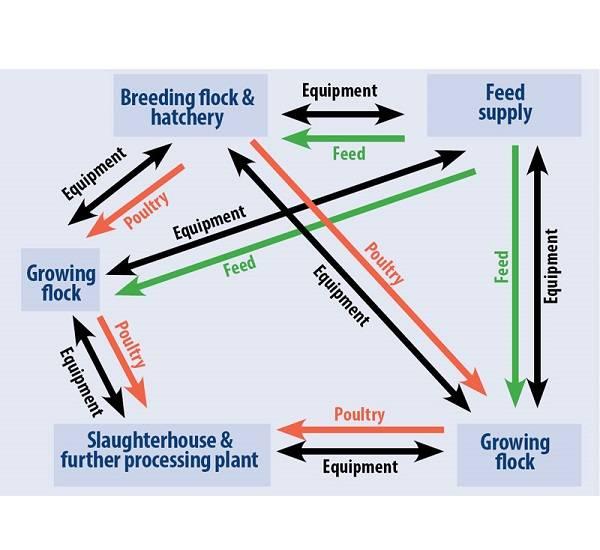WattAgNet: Analysis: Solutions for trade during avian influenza outbreak07-05-2015
The emergence of avian influenza symptoms in poultry flocks in part of a country does not have to lead to a total trade suspension.
Release Date: 2015-05-07
By Mark Clements
The well isolated Cobb complex in Agua Clara, Mato Grosso do Sul, Brazil, with three rearing and six production units. The emergence of avian influenza symptoms in part of a country does not have to lead to a total trade suspension. As avian influenza continues to spread, concerns are growing over its impact on trade in broiler meat and poultry genetics. Through its Terrestrial Animal Health Code, The World Organisation for Animal Health (OIE), the standard-setting body for animal health, provides guidance for veterinary authorities to establish zones and regions free from avian influenza, and for poultry companies and veterinary authorities to maintain compartments recognized as free from the disease for the purposes of exports. Some countries have been quicker than others in publishing national legislation to allow companies to apply for recognized compartment status, however, failure to update avian influenza legislation nationally should not be seen as a barrier to companies implementing the OIE’s recommendations.
How compartmentalization works
Where breeding stock is concerned, compartmentalization is particularly important as it should allow the shipment of stock, even if there is an avian influenza incursion in the country where the company has its breeding facilities. The concept was first put forward by the OIE a decade ago in recognition of the difficulty faced by some countries in fully eradicating certain diseases from their territories as a whole, or to maintain disease-free status in part of their territories. In the case of the poultry industry, compartmentalization is a procedure to establish bird subpopulations of distinct health status based on management and biosecurity factors. Flocks within the compartment should be contained within one or more establishments under a common biosecurity management system to preserve a distinct status with respect to a specific disease or diseases within a country. While zoning applies to subpopulations defined primarily on a geographical basis, compartmentalization is applied to subpopulations defined primarily by management and husbandry practices related to biosecurity. In practice, however, spatial considerations and good management play important roles in the application of both concepts. The establishment of a compartment is a preventative measure where avian influenza or Newcastle disease is concerned, serving both to guarantee the health status of a bird subpopulation and to avoid interruptions to trade in poultry and poultry products. It is preferable, the OIE says, to establish a compartment at a time when a country or zone is free from the disease or diseases for which the compartment is being created, however, not all countries have been active in developing their own legislation to aid the industry in the establishment of compartments. Compartments can, through bilateral agreements between the veterinary authorities of the countries involved, result in the continuation of trade even in the event of changes in the health status in the country or zone. The recommendations for compartments in the OIE’s Terrestrial Code cannot be applied in all situations. The effective implementation of the concept depends, amongst other things, on the epidemiology of the disease, individual country factors, environmental factors, biosecurity measures which may be applicable, the health status of adjacent areas, surveillance and the relationship between the public and private sectors.
Unjustified avian influenza outbreak restriction
While compartmentalization and zoning are designed to allow trade to continue in the event of a disease outbreak, do the systems work? Internationally accepted rules may be followed to the letter by one party, but the final decision to accept exports in the event of an avian influenza outbreak will always lie with the receiving country. Following the outbreaks of avian influenza in Europe late last year, the International Poultry Council (IPC) said that it was essential that measures taken by national authorities to protect their flocks against the virus were appropriate and adequately resourced, but that they must also be proportionate to the actual level of risk, and must not needlessly disrupt trade, particularly in breeding stock. The IPC called on its members to urge their national authorities to consider only those measures that relate to real risk to domestic poultry flocks, adding that some importing countries had needlessly banned transit of poultry, including breeding stock, through affected countries, without considering real risk level. National authorities must be urged to recognize regionalization as a more proportionate and risk-based alternative to country-wide bans in poultry and poultry products, it said. It also continued that a few poultry companies in conjunction with national authorities had already adopted compartmentalization and that importing countries should accept and approve the few compartments that already exist and the concept should be more widely adopted. In May this year, the IPC wrote to the OIE urging it to encourage its members to abide by the OIE guidelines when imposing trade restrictions on poultry meat and breeding stock. “The reaction of many national veterinary authorities has been to impose national bans on all poultry imports without consideration of alternate risk management strategies. National veterinary authorities may not be using all the available measures agreed by the OIE for continuation of trade, specifically in the kind of disease circumstances currently being experienced.” The IPC continues that countries that are members of the OIE have agreed to procedures for the conduct of trade in breeding stock, live poultry, and poultry meat, including compartmentalization, zoning and regionalization, for managing safe trade in the event of notifiable avian influenza outbreaks in exporting countries.
Compartmentalization is a procedure to establish bird subpopulations of distinct health status based on management and biosecurity factors. |
Inloggen op de ledenportal
.png)
